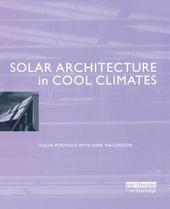
|
Solar Architecture in Cool Climates
Paperback
Main Details
| Title |
Solar Architecture in Cool Climates
|
| Authors and Contributors |
By (author) Colin Porteous
|
|
By (author) Kerr MacGregor
|
| Physical Properties |
| Format:Paperback | | Pages:288 | | Dimensions(mm): Height 245,Width 200 |
|
| Category/Genre | Architectural structure and design
Alternative and renewable energy sources and technology |
|---|
| ISBN/Barcode |
9781844072811
|
| Classifications | Dewey:333.7923 |
|---|
| Audience | | Undergraduate | | Postgraduate, Research & Scholarly | | Professional & Vocational | |
|---|
| Illustrations |
Photographs, tables, index
|
|
Publishing Details |
| Publisher |
Taylor & Francis Ltd
|
| Imprint |
Earthscan Ltd
|
| Publication Date |
1 July 2005 |
| Publication Country |
United Kingdom
|
Description
'A must-read for practitioners, teachers and others interested in or working with energy use in the built environment, including a delightful set of examples' Ann Grete Hestnes, former President of the International Solar Energy Society Solar Architecture in Cool Climates is an invaluable primer on low energy building design, combining accessible information with convincing arguments enabling new techniques to be implemented in daily practice. Approaching the topic in a thematic manner, the book provides inspiration, an understanding of key principles and technical data on the design of solar buildings in higher latitudes. The text is enlivened through direct experience of case studies from Europe and North America dealing with new-build, retrofitting and conceptual projects that outline future potential (the principles being equally applicable to equivalent southern latitude locations. The authors examine the dilution of additional costs through different strategies, the tensions between energy efficiency and environmental quality, and the proactive control of energy in building design. Promoting flexibility and opportunity to a diverse audience, including those who use, procure and finance buildings, the book aims to bring the design of 'green' solar buildings in cool climates from special interest status into the mainstream. Broader environmental issues relating to solar architecture are addressed in the final chapter, again drawing on case studies from the authors' own wide experience. Solar Architecture in Cool Climates is written for architects and other building designers, students of architecture and other professionals interested in sustainable architecture, renewable energy and engineering.
Author Biography
Colin Porteous is Professor of Architectural Science and Senior Research Fellow at the Mackintosh School of Architecture, Glasgow School of Art, where he has worked since 1986, following 19 years in architectural practice. Kerr MacGregor is Managing Director of MacGregor Solar, having previously founded the Scottish Solar Energy Group and worked as senior lecturer in mechanical engineering at Napier University.
Reviews"Although not camouflaging the scientific principles of energy flux in buildings, Porteous (Glasgow School of Art) and MacGregor (practitioner) have targeted Solar Architecture in Cool Climates to architects and their teams in order to illuminate through specific case studies in Europe--notably Scotland, Denmark, the Netherlands, and Germany--how buildings in wetter, cooler regions can be designed to take better advantage of available solar energy. Utilizing clear illustrations and photographs, the authors expound, in seven chapters, on the often-significant difference between the expected or designed energy performance of buildings and the results of monitoring actual energy consumption over time when the buildings are occupied. Techniques and technologies including glazing, transparent insulation, and thermal heat sinks for capturing and storing solar energy are discussed, and culminate in the chapter 'Environmental Comfort and Well Being.' Chapters devoted to adaptive, passive and machine controls of solar energy as well as examples from North American practice provide readers with specific design examples. The authors conclude with an examination of the political, technological, social, and psychological driving forces associated with making green solar architecture real. An excellent companion to Solar Architecture, ed. by Christian Schittich (2003). Endnotes. Summing Up: Highly recommended. Graduate students through professionals; two-year technical program students."--L. B. Sickels-Taves, Eastern Michigan University in CHOICE
|